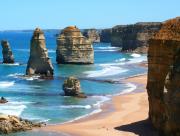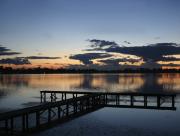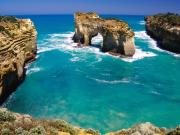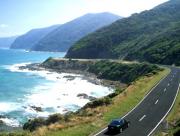Great Ocean Road Suggested Itinerary
via The Great Ocean Road, Grampians and Ballarat.
Day 1: Melbourne to Apollo Bay
Distance 200km Approx drive time 3 hours
Depart Melbourne via the West Gate Bridge and follow the Princes Freeway towards Geelong. The historic Werribee Park Mansion and Point Cook National Aviation Museum are both accessible from the freeway or stop at Serendip Sanctuary, situated near the township of Lara. Over 150 species of birds have been recorded in the sanctuary and visitors can view this native wildlife at close range.
Spend some time in Geelong visiting the National Wool Museum, which is housed in a century-old bluestone Woolstore, and documents Australia's wool industry from fleece to completed garments. Other features of this regional city are the restored art deco Eastern Beach Baths Complex, and its newly developed waterfront and unique bollard sculptures.
Travelling on from Geelong you can also visit the Bellarine Peninsula and Port Lonsdale and Queenscliff. Historic Queenscliff combines stately 19th century Victorian architecture with fisherman's cottages and is home to Australia's largest best preserved military fort. There are breathtaking views of Port Phillip Bay can be seen from the "Rip" lookout at Point Lonsdale. From here it is a short drive to Torquay where the surf world Museum documents surfing history in the region. Along Bells Beach, Torquay is recognised among the world's premier surfing locations and marks the beginning of the Great Ocean Road.
Continue on through the townships of Anglesea and Aireys Inlet to Lorne, a resort style town combining restaurants and shops with natural attractions such as the Angahook-Lorne State Park. Leaving Lorne, continue on in the direction of Apollo Bay, the contrast between rugged coast and inland forest becomes more spectacular. This fishing and farming village is also an excellent base for exploring the waterfalls and rainforests in the Otway National Park.
Day 2: Apollo Bay to Port Fairy
Distance 200km Approx drive time 2 hours and 30 minutes
Continue your drive along the Great Ocean Road through the Otway National Park. Stop at Maits Rest and take the self guided rainforest walking trail through the park. Here tall Mountain Ash trees tower over the lush tree ferns and moss covered vegetation.
A little further on, you may wish to take a short detour to Cape Otway. This 13 kilometre drive winds through thick forest canopies to reveal native Australian animals and spectacular coastal views from the headland.
Back on the main road, the stretch of road from Lavers Hill onward is a highlight. It traces limestone cliffs along the "Shipwreck Coast" aptly named as more than 50 ships have run aground or struck reefs and sunk. The limestone rock formations have been carved away from the mainland over thousands of years. These natural monuments from a stunning panorama and are a part of the Port Campbell National Park. Some of the highlights include the Twelve Apostles, Loch Ard Gorge and London Bridge. Viewpoints are signposted with information boards, boardwalks and parking for easy access.
Nearing Port Campbell, the road passes by wetlands and estuaries which are inhabited by various species of birdlife. At Peterborough, you will see other rock formations, such as the Bay of Martyrs and Bay of Islands.
Continue on to the city of Warrnambool, a one time whaling centre which now attracts visitors to observe the large mammals. Southern Right Whales appear each year between May and September, and can be viewed from Logans Beach. It is then a short drive to Port Fairy, one of Victoria's earliest fishing ports. Many of the limestone and bluestone buildings date from the 1840s and have been classified by the National Trust.
Day 3: Port Fairy to Halls Gap
Distance 160km Approx drive time 2 hours
Retrace your drive yesterday back towards Warrnambool and take the turnoff for Penshurst before Warrnambool. From Dunkeld, a scenic drive will take you through the Grampians National Park and onto Halls Gap. This is also an ideal base for bushwalking and discovering Australia's unique native animals in their natural habitat. Highlights include Mt Victoria Lookout, Mackenzie Falls, Reids Lookout and the Balconies. The Grampians are renowned for the fine collection of Aboriginal cave paintings and the Brambuk Living Aboriginal Cultural Centre, which gives visitors an insight into Aboriginal culture, history and art.
Day 4: Halls Gap to Ballarat
Distance 140km Approx drive time 1 hour and 30 minutes
Depart Halls Gap from Pomonal, a small village on the edge of the Grampians National Park which provides access to the Lake Fyans Tourist Route, and continue on to Ararat. From here it is a direct drive along the Western Highway to Ballarat - a living memorial to the Victorian goldrush of the 1850s. discover the city's gardens, well preserved buildings and statues and experience the setting and atmosphere of the goldfields at Sovereign Hill, a living outdoor museum. Other attractions include Ballarat Wildlife and Reptile Park and Lake Wendouree.
Day 5: Ballarat to Melbourne
Distance 115km Approx drive time 1 hour and 10 minutes
A drive along the Western Freeway will then take you in the direction of Melbourne. Points of interest along the way include The Lerderderg Gorge State Park, which features a popular walking track taking in panoramic views of the dramatic gorge formation. The Brisbane Ranges National Park is also close to the freeway and has many excellent walks.
Suggested Accommodation
· Cumberland Lorne Resort
· Mantra Erskine Beach Resort
· Peppers the Sands Resort






